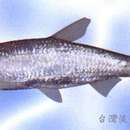en
names in breadcrumbs


The sharpbelly or wild carp, sharpbelly, or common sawbelly (Hemiculter leucisculus), is a tropical freshwater and brackish water fish belonging to the Cultrinae subfamily of the family Cyprinidae. It originates in large streams and reservoirs in China, Taiwan, Japan, Hong Kong, Korea, and the Amur River basin. It has become established as an exotic species in several other countries, including Iran, Afghanistan, and the former Soviet Union, where it has displaced local species. It was originally described as Culter leucisculus by S. Basilewsky in 1855, and has also been referred to as Chanodichthys leucisculus and Hemiculter leucisculus warpachowskii in scientific literature.
The fish reaches a size up to 23.0 cm (9.1 in) long, and is native to fresh and brackish water habitats with a pH of 7.0, a hardness of 15 DH, and a temperature of 18 to 22 °C (64 to 72 °F). It is green-gray on the back, and white in the belly.
The bulk of its diet includes zooplankton, insects, crustaceans, algae, and detritus. It is of minor commercial importance, primarily in China, where it is canned. In Hong Kong, it is not favored as a table fish because the flesh is unpalatable and very bony.

As most fish species, the sharpbelly harbours several species of parasites. One of them is Paradiplozoon hemiculteri, a monogenean living on the gills.[2] This species is special in that the two hermaphroditic members of the couple are united for life.
The sharpbelly or wild carp, sharpbelly, or common sawbelly (Hemiculter leucisculus), is a tropical freshwater and brackish water fish belonging to the Cultrinae subfamily of the family Cyprinidae. It originates in large streams and reservoirs in China, Taiwan, Japan, Hong Kong, Korea, and the Amur River basin. It has become established as an exotic species in several other countries, including Iran, Afghanistan, and the former Soviet Union, where it has displaced local species. It was originally described as Culter leucisculus by S. Basilewsky in 1855, and has also been referred to as Chanodichthys leucisculus and Hemiculter leucisculus warpachowskii in scientific literature.
The fish reaches a size up to 23.0 cm (9.1 in) long, and is native to fresh and brackish water habitats with a pH of 7.0, a hardness of 15 DH, and a temperature of 18 to 22 °C (64 to 72 °F). It is green-gray on the back, and white in the belly.
The bulk of its diet includes zooplankton, insects, crustaceans, algae, and detritus. It is of minor commercial importance, primarily in China, where it is canned. In Hong Kong, it is not favored as a table fish because the flesh is unpalatable and very bony.